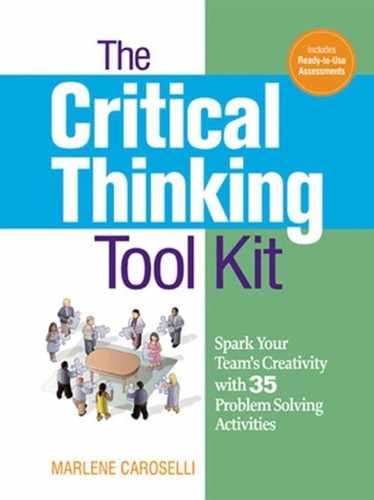#33: Giving Problems a Why’d Berth
Overview: |
After being presented with an example, participants will apply the Five-Why technique to a current workplace problem and then to a situation involving recent news events. |
Objective: |
To afford practice with the Five-Why technique. |
Supplies: |
Copies of a recent news article, one per participant |
Time: |
About 20 minutes |
Advance |
Make copies of a recent news report that invites in-depth analysis. If you can, arrange seating so table groups of five or six can work together. |
Participants/ |
Any number of participants can work on this exercise, which works best as a mid-session or end-of-session skill-builder. By the halfway point in the course (or by the end), enough provocative questions or issues will have arisen to warrant the Five-Why application. |
Introduction to Concept:
A popular problem-solving tool from the world of Total Quality Management (TQM) is the Five-Why technique. It has one person continuing to ask “Why?” until the root cause of a problem has been uncovered. This example shows how continued questioning helps us to analyze the multiple factors involved in problems, and not just the most obvious, most superficial ones.
William’s variance report is late.
Why?
He’s always playing catch-up.
Why?
He’s been assigned to a two-week training program during the middle of budgets.
Why?
He really needs the training.
Why?
He was never given an orientation program when he was first hired.
Why?
I guess he just slipped through the cracks.
With this kind of probing, it is much easier to uncover the root cause of the problem. And that root cause, as we saw in William’s case, may well go beyond the circumstances of the particular problem being investigated. While the lateness of a given report may be serious, more serious is the problem of employees not having the training they need to do the job before they start to do that job. The slipping-through-the-cracks problem is the long-term one that needs immediate attention.
Procedure:
1. Working in teams of five or six, participants will record problems that occur/exist in the workplace or in any other context they wish to address.
2. They will probe beneath the surface of the problem (as originally stated) to attempt to learn the real cause and, thus, what might be the real solution.
3. A representative (or two representatives, if there are only a few teams) from each team will meet with other representatives to prepare a report on what the various teams learned. As this special team is working, the remaining participants will work on a second exercise—applying the Five-Why technique to a recent news story in an effort to uncover beneath-the-surface causes for a given effect. Distribute the news story.
4. After 10 or 15 minutes, ask for the two reports: the first by a spokesperson for the special team and the second by a spokesperson from the team that discussed the recent news story.
Extending the Activity:
1. Invite a guest speaker (a senior manager, a community leader, a police officer) to address the class about a common problem. An appointed spokesperson from the class will ask (as professionally and diplomatically as possible) five “Why?” questions to get beneath surface discussions.
2. Ask participants to think about the last five major problems they solved or decisions they made. Have them discuss with one or two others the depth to which they probed beneath the surface to find root causes of the problems.
Workplace Connections:
1. Recommend that employees use the Five Why technique the next time they are tempted to hurl an accusation at a co-worker. Instead of jumping to conclusions and saying things they might later regret, participants can use the five “Why” questions as a means of exploring the problem instead of attacking the person with the problem.
2. Suggest that participants share this technique with their supervisors for future use.
Questions for Further Consideration:
1. What is causing some of the communication problems in your workplace?
2. Specifically, how should managers deal with employees who have problems?
